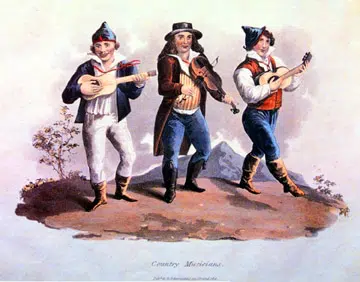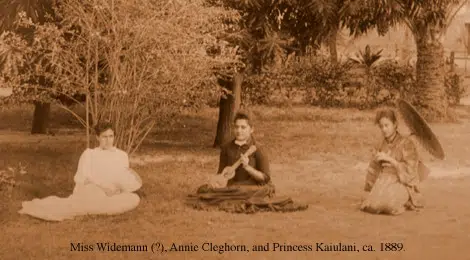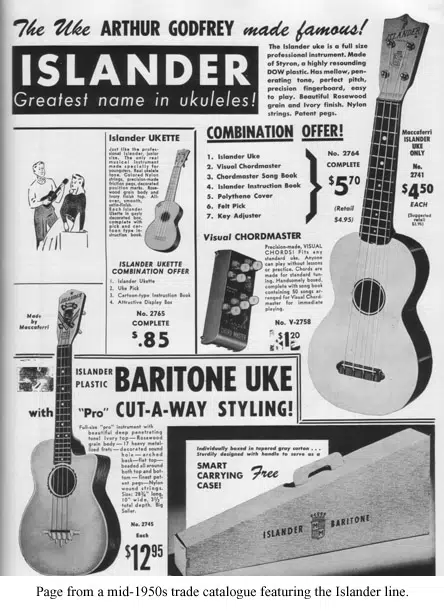This very brief ukulele history originally comes from UkuleleHunt. It was written by Alistair Wood and reproduced with permission. Big thanks to him for allowing me to post this! If you’re looking for an extensive and accurate guide, take a look at John King’s Nalu Music. What follows is a very brief and sometimes not all that accurate history of the ukulele.
Ukulele history starts in Europe
By the 18th century, there was already a long tradition of stringed and fretted instruments. Larger guitars and lutes had been developed in smaller versions that were particularly popular with seafaring musicians. In Portugal, the guitar had shrunk down to become a ‘machete’, retaining the figure-of-8 shape. Although the shape was no longer necessary on such a small scale.

In 1879, the Ravenscrag set sail for Hawaii with four Portuguese cabinetmakers on board. They started making instruments for the poor, rural population of the islands. The instrument that really took hold was a new version of the machete.
Much of the truth behind ukulele mythology has been lost to us. Where did it get its name? What about the tuning? And why was it given the name ‘jumping flea’? One aspect of ukulele history is a fact: it was a big hit with the Hawaiian royal family and Hawaiians in general. By the beginning of the 20th century, the ukulele had become firmly established as their national instrument.
Businessmen stole Hawaii from the Hawaiians
After the US annexation of Hawaii – or when the “businessmen stole Hawaii from the Hawaiians”, as Bob Brozman puts it – the new rulers were keen to market the archipelago to mainland America as a tropical island dream. Their push was the Panama-Pacific International Exposition in 1915. It included plenty of ukulele music and featured the ukuleles of Jonnah Kumalae. This sparked the ukulele boom in the 1920s among people dreaming of a mythical island getaway.

Then ukulele history started to move away from a purely Hawaiian novelty. The instrument became so intrinsic to musical culture that by the start of the 1930s, most piano scores featured ukulele chord diagrams. Thanks to Ukulele Ike, the uke’s image was almost completely turned on its head, becoming associated with smoky bars, trilbies and jazzy songs.
Boost in music halls in the UK
When Wall Street collapsed in 1928, the American economy took a nosedive. So did the popularity of the ukulele.
However, the ukulele started becoming popular in music halls in the UK instead. Here musicians preferred the louder, harsher-sounding banjolele. The biggest star of the era was George Formby, whose banjolele strumming was the quintessential sound of the Second World War. Formby gave the history of the ukulele a real boost.
WWII also sparked a revival of the ukulele in the US. Troops returned from Hawaii with souvenir ukuleles. After the war, the islands’ accession to official US statehood was the perfect occasion for a celebratory strumming.
The booming consumer economy of the US in the 1950s US led to mass-produced plastic goods flooding the shops. A ukulele was an ideal instrument to sell to children on a massive scale. The jazz guitar manufacturer Maccaferri pounced on the opportunity, introducing a range of plastic ukes.
Arthur Godfrey en Tiny Tim
This was bolstered by the use of the ukulele by the TV star Arthur Godfrey. The second ukulele boom came into being.

The rather less aspirational figure of Tiny Tim was the soundtrack to the uke’s plummeting popularity in the 1960s and 70s.
For most of the 1990s, the alternative music scene was dominated by traditional guitar bands. As a reaction to this, the first decade of the 2000s saw a growing acoustic alternative scene that used more eclectic sounds and more unusual instrumentation. The ukulele found a place in this sound with bands like `The Magnetic Fields’.
The internet makes the ukulele popular again
Two very important trends have helped to make the ukulele popular again. The first was the emergence of the internet, followed by the huge increase in imports from China and the East. The internet has introduced many people to ukulele music. This has created a groundswell in the number of people who have been inspired to pick up the instrument by others like themselves. Many play for their own enjoyment rather than superstardom.
Need more input on ukulele history?
Feel free to contact me whenever you need more information about the history of the ukulele, because this is really only a brief overview.
Since you’re here, would you like to know more about the parts of the ukulele?
